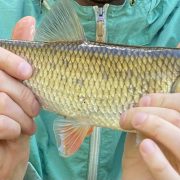
Looking at some of the pieces that have recently come out of the kiln, like the one above, anybody might think that Peter Arscott Ceramics is keen on making work that displays the principles of movement, by showing flowing lines and edges that we find in the natural world. But it is rhythm and pattern in the mark making that is of primary concern and this sometimes leads to this impression of movement – repetition of elements or colours. We are just as keen on placing spots on the surfaces, which achieve the opposite, anchoring a design, like the one below.

Talking of repetition, staff meetings are held regularly at PAC. One was recently held to discuss stock levels. Over coffee, Thelonious (pug mill), Spyridon (marketing), Ziggy (fly control) and I agreed that there is nothing worse than having stock that is uncherished and unseen. Subsequently, we are going to display those pieces that didn’t quite make the grade, those “not quite right” vases, those skewed pieces, those stunted or, frankly, unresolved ceramics that have been lurking in some dark corner of the studio, forgotten and unloved but which will for once have a chance to have others cast their eyes on them and decide their worth.

Spyridon, Thelonious and Ziggy
Because all these stoneware vessels are fired to such a high temperature in the kiln (1270°) they are essentially vitrified and will withstand any temperature out in the garden. They are frost-proof. And you’d be surprised how good the most questionable ceramic can look once it has been strategically placed outdoors among shrubs and bushes, or on terraces, or on a balcony or windowsill with suitable plants in them. You may even like one enough to put on your kitchen table, but what I am saying is that despite their flaws they retain some allure if carefully positioned around or outside the house.

So obviously we are not going to charge you for any of these little ceramic orphans. No. We are going to ask those of you who come to see and take, to leave a donation in a box that will be left outside in the garden near the display. You can leave as much or as little as you like, but it will go to a charitable cause.

Thelonious wanted any money to go to a retirement scrapyard for old pugmills, Spiro pressed for donations to go to a home in Greece for retired goatherds, and Ziggy, despite our best attempts at explaining the idea of “charitable” to him, wanted to invest it all in a large glass maggot-breeding farm and fly dispenser. However, as the boss, I have decided that it should go to towards the Ledbury Poetry Festival Community Projects at the new Poetry House in Ledbury to help cater for the many communal events planned to take place there.

“What’s poetry got to do with pottery?” sneered the sulking Ziggy.
“The only difference is the letter t” I riposted.
“You’ve said that so many times before that it is no longer witty,” murmured Spiro.
“Yes,” added Thelonious, “you are repeating yourself quite often nowadays.”
“Listen, you lot,” I said with rising anger, “this is all a bit rich coming from a cast iron contraption that can only compress used clay! As for you, Spyridon, I haven’t heard you ever say anything witty, possibly because you are a third century goatherd and Bishop of Trimythous, but mainly (I suspect) because you are a figment of my imagination, one to whom I have entrusted this enterprise’s marketing campaign!”
There was a hushed silence in the studio.
“And Ziggy, don’t forget that, as a spider, you are here on sufferance because you keep the fly population under control.”
There followed murmured protests and vague threats of a strike, which (like the present government) I chose to ignore. Then my wife came into the studio with a suspicious look in her eyes and asked me if I’d been talking to myself again, which I denied. Perhaps I have been working on my own too much.

So, if you are interested, please make your way to Oakland House, The Homend, Ledbury, HR8 1AP and park on the road, if you are driving, by the gate, skip up the seven steps into the front garden and have a look. If anything takes your fancy, take it and leave your donation in the nearby box. The images accompanying this blog show some of the ceramics that will be on display. They will be there on Saturday 16th and Sunday 17thJuly, from 10am to 6pm.

For those of you wanting to spend as little as possible (hard times and steeper bills are heading our way, after all) there will also be some small three legged bowls to choose from, mainly from when Peter Arscott Ceramics used to be “belatrova” – you’ll find the “b” mark on those, as opposed to the PAC mark.

Although somebody will be at home , Covid has struck, so nobody contagious will come out to greet you. A forlorn wave from a window is all you might get, though staff, being a machine, a figment and a spider, are not affected. Finally, and with Ziggy’s woeful attitude in mind, and because this is a ceramics blog, and because we have had a highly successful Ledbury Poetry Festival, I’ll finish with the part of the last stanza of John Keat’s poem, Ode to a Grecian Urn:
When old age shall this generation waste,
Thou shalt remain, in midst of other woe
Than ours, a friend to man, to whom thou say’st,
“Beauty is truth, truth beauty, —that is all
Ye know on earth, and all ye need to know.”

John Keats by William Hilton, National Portrait Gallery


























































































































